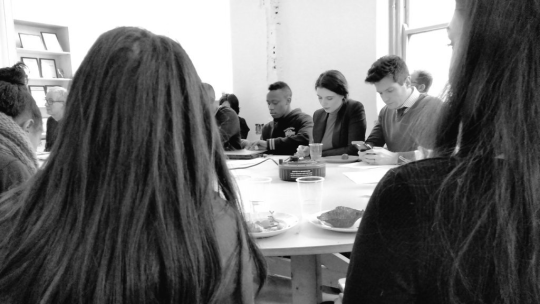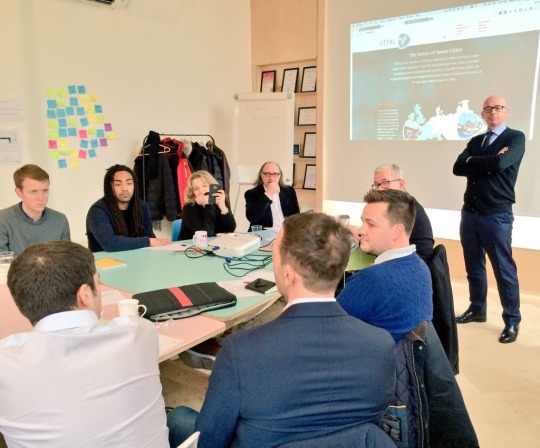
Workshops with end users and service providers for an Internet of Things pilot took place at Camden Collective in London on March 9, 2016. The pilot, by the VITAL IoT consortium, explores how the explosion in real-time data from internet-connected objects and services can better support the growing number of people and businesses who habitually work on the move.
The international consortium of software giants, research institutes and city innovators was set up with the support of the European Commission to unlock the power of the Internet of Things for developers by tackling the disconnect between different legacy systems and data formats with new, easy-to-use technologies. Established almost three years ago, VITAL has developed a platform and a range of tools which it is now trialling in two pilots: mobile working in London and traffic management in Istanbul.
The day before the workshops, the consortium convened at London South Bank University to discuss progress and rolling out the technology when the pilots have been completed. Professor Janet Jones, the Dean of LSBU’s School of Arts and Creative Industries, hosted a lunch for the consortium to meet with academics from across the university and with businesses in its enterprise networks.
The workshops – at Camden Collective’s new hub at the disused Temperance Hospital just behind Euston Station – were designed to try out and provide feedback on a prototype workspace finder application that aggregates a range of IoT data to offer the user choices best suited to their professional and personal needs from five participating workspace venues. Prototype live data included footfall (from CCTV camera feeds), transport including cycle hire (from Transport for London API), air quality (from London DataStore) as well as interior readings of light levels, temperature and humidity from sensors installed within the venues as part of a collaboration with the Digital Catapult. This live data – all integrated through VITAL’s programmeable platform interfaces (PPIs) – is put together with location maps and other information from venue providers and other workspace users, then matched with the user’s profile and preferences to return optimally ranked choices.

The morning session took the form of end user testing with a large group of workspace users and app developers, all born digital and mostly in their early twenties. Even though the prototype application is still in its early development stages, the response from this group was enthusiastic. “We now have smart phones, it’s time we had smart apps,” said one. Two thirds felt that VITAL would enable developers to work more easily with different IoT architectures and ecosystems. 78% thought the technology would deliver more efficient management of smart city systems and even more – 89% – felt it would have the effect of innovating such systems.

Asked what factors would weigh in their choice of workspaces, most opted for an enjoyable, organised and comfortable working environment, closely followed by being able to connect with the right networks of other workspace users: knowing who else is there and communicating via the app. Distance from the nearest station was the top locational requirement, followed by nearby lunch places. Cost and availability were also listed.

Service providers attended the afternoon session to discuss the app and the feedback from end users. Participants in this session included representatives from the participating workspaces, the local authority (the London Borough of Camden), KPMG, Tech City Ventures and Digital Catapult. Once again the engagement was positive, with participants agreeing that aggregated live data would become increasingly useful. Workspace providers welcomed the opportunity of obtaining more information about how and by whom their facilities are used, particularly about networks, connections and users. It was also felt that this approach might allow development of dynamic pricing models in addition to existing membership structures, and that this would support the changing patterns of working.

Workshops to evaluate the Istanbul traffic management prototype – which aggregates live data from more than 3,000 fixed and mobile sensors monitored and aggregated through the VITAL IoT platform – will take place next month. Further workshops to evaluate the platform are planned in Turin, Madrid, Lille, Athens and Galway later in the year.
The industrial backbone of the consortium is provided by Atos’ IoT Lab in Madrid, the Italian software giant Reply and Greece’s largest software integrator, SingularLogic. The research base is contributed by Insight, Europe’s top data analytics centre based in Galway, the French national institute for research in computer science and automation Inria, the faculty of computer engineering and informatics at Istanbul Technical University, and the top private-sector academic institution in Greece, Athens Information Technology. The city partners are Camden Collective, the London and Manchester-based design and innovation group Images&Co, and the traffic division of Istanbul municipality.
The consortium sees VITAL as an effective, low-cost, open-source solution for connecting legacy systems and data sources within and between cities as well as creating opportunities for bottom-up IoT application development by startups and SMEs. A beta version of the platform is due to be released in the fall of 2016 and the consortium is formulating plans for growing an open-source IoT community and working with cities, academic and SME partners to roll out the VITAL platform and tools.

